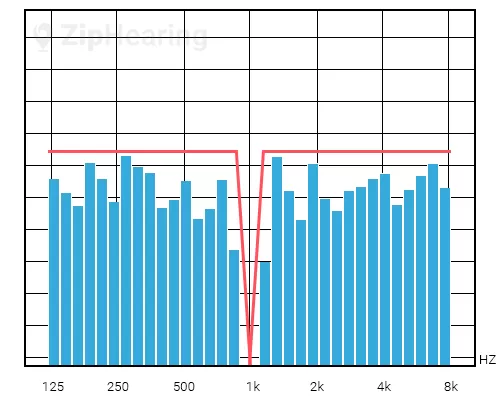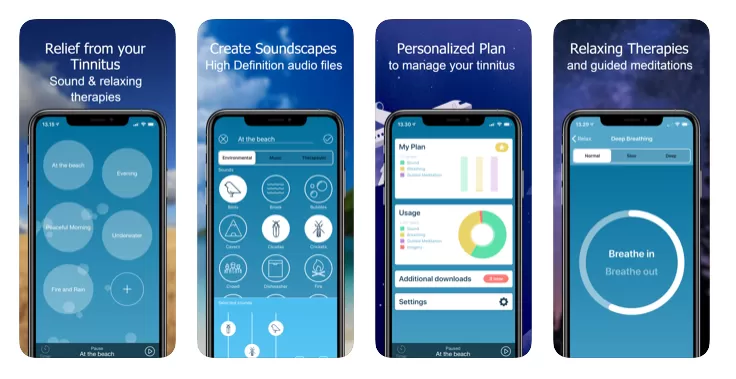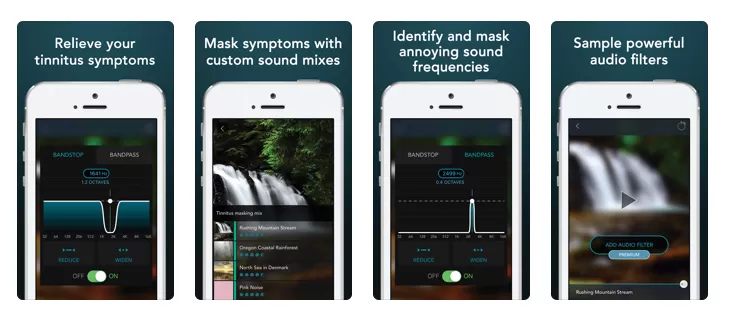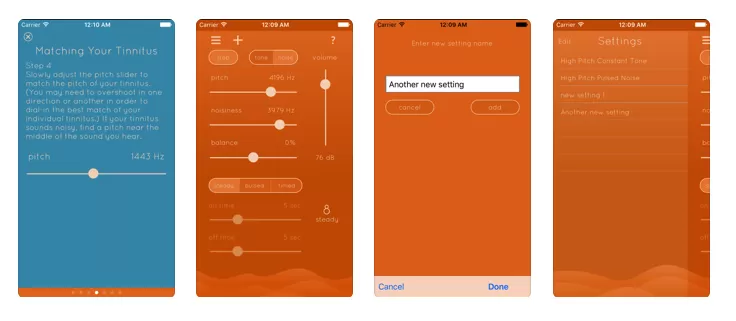Hearing Aids for Tinnitus
The ultimate guide to finding tinnitus relief through hearing aids
The U.S. Centers for Disease Control estimates that nearly 15% of the general public — over 50 million Americans — experience some form of tinnitus.
If you're one of those 50 million, you may be wondering if it's possible to use hearing aids for tinnitus relief.
Believe it or not, one of the most common treatment options medical professionals recommend, is hearing aids.
In this post we’ll review how modern hearing aids and smartphone apps can provide tinnitus relief.
We’ll explain what these products do, how they are supposed to work, and what we think of them.
How hearing aids can help with tinnitus
Hearing aids won't make tinnitus disappear.
Unfortunately, for the vast majority of tinnitus cases, there is nothing that will make it disappear.
Instead, the way hearing aids aim to provide tinnitus relief, is by reducing an individual’s perception of their tinnitus, thereby relieving the negative side effects often associated with tinnitus, such as stress and anxiety.
This relief is provided by shifting the focus of an individual’s attention away from the tinnitus noise, by either masking the tinnitus, or retraining the brain to focus on other sounds.
This is accomplished through what is called “sound therapy,” which is a broad term to encompass several of the most popular approaches to tinnitus relief, such as hearing aid amplification, habituation, and notch therapy, alone or in combination.
There is no convincing evidence that any one of these approaches works better, on average, than the others. However, individual listeners may respond differently to each approach.
Even identical twins with apparently equivalent hearing may express completely different preferences regarding tinnitus therapies.
All three methodologies should be considered and discussed with a hearing care provider, and if needed, multiple hearing care providers.
Let’s first look at the most common and most successful way to relieve tinnitus—hearing aid amplification.
Relief through amplification
Hearing care professionals agree almost unanimously that most people who have tinnitus and wear hearing aids will experience some relief from tinnitus, when wearing their hearing aids.
Just how many people will experience relief through amplification?
Figures vary, but one survey puts this number above 60%.
Why does hearing aid amplification help?
There's two reasons.
First, hearing aid “machine noise” acts like a built in sound generator. Also called “circuit noise” or “internal noise,” a hearing aid circuit inherently produces some very low level sound, a barely perceptible white noise, which as we’ll explain in more detail below, helps to mask the tinnitus noise.
Second, amplification reduces listening fatigue. If you’re constantly straining to hear, that brings attention to your tinnitus, making it more noticeable.
So, hearing aids alone will provide some tinnitus relief.
But if you get new hearing aids and you’re still bothered by your tinnitus, then it’s time to look at additional ways hearing aids can help (below).
Relief through habituation
Oddly enough, one of the most popular forms of sound therapy involves introducing even more sound (external noise) to the picture.
We know it sounds crazy, but hear us out.
First, ponder this question-
What is more noticeable, a burning candle in a bright room, or a burning candle in a dark room?
Obviously- a candle in a dark room will be more noticeable.
And if we want to make the candle less noticeable, we simply add light to the room.
This simple metaphor is often used to describe the rationale behind adding more noise, to what already feels like a pretty darn noisy situation (tinnitus).

Simply put- when all an individual can hear is their tinnitus, that tinnitus seems much more noticeable and bothersome.
Another metaphor is that of a barking dog.
Imagine your neighbor’s dog is barking sporadically through the night, preventing you from sleeping.
You probably wouldn’t hesitate to add some sort of white noise to the room, to help “drown out” the dog barking, allowing you to sleep.
While you may still hear the dog barking in the background if you focus on it, the constant and steady white noise will allow you to shift your focus away from the barking, allowing you to sleep.
So the goal of sound therapy is to “brighten” your auditory “room”, making that lit candle (tinnitus) less noticeable, or to drown out that annoying dog that won't stop barking.
This isn’t just a nice idea, there’s real science behind the phenomenon that allows an individual to “tune out” what they don’t want to notice.
It’s called habituation, and we’re all doing it, all the time.
If you spray yourself with perfume or cologne in the morning, after a short while you get used to the scent and stop noticing it.
If you buy a new clock and are annoyed by the loud ticking, a few days pass and you’re eventually able to tune out the clock, due to habituation.
The goal of this kind of sound therapy, and the entire principle behind adding more sound, is to foster habituation, shifting the focus of your brain to a steadier, more constant, calmer stimuli, allowing you to eventually tune out the tinnitus.
You now have a basic understanding of why sound therapy and external noise can help make things better, but, from where does this “external noise” come?
Technically- almost any sound-producing device can be used for masking purposes, including personal audio devices, computers, radios, TV, electric fans, and water fountains.
But for the purpose of this post, we’re going to look at external sounds provided by hearing aids, which are sometimes referred to as “hearing aid sound generators.”
The most common sounds used in hearing aids to help relieve tinnitus are masking noise and fractal tones.
Masking Noise
WARNING: Turn the volume down on your device before playing the audio sample below.
Masking noise can technically be any noise used to reduce the perception of another noise.
But white noise (like in the audio sample above), is the most common sound used for tinnitus therapy.
Why?
White noise contains all audible frequencies distributed uniformly throughout the spectrum, and as a result, makes it an excellent masker for tinnitus.
It’s similar to how a noisy restaurant makes it hard to understand conversation- all those competing sounds at various frequencies produce a serious masking effect.
If that audio file above sounded awful to you, rest assured, not all masking noise is created equal.
White noise, red noise, pink noise, brown noise- they all sound different, and have audio characteristics that will serve some individuals better than others.
You may not like white noise, but will find that pink noise is more tolerable and provides the right relief for your tinnitus.
It’s up to you and your hearing provider to try different options and see which noise might be right for you.
And don’t worry, whichever noise you choose isn’t going to be very loud.
Masking noise is usually presented at a slightly quieter volume level than tinnitus, but finding the right volume level will require some trial and error.
The “sweet spot,” is usually is the level at which the tinnitus noise is still heard, but the relative loudness of it is reduced by having background sound therapy at a lower level, which then diminishes the perception of the tinnitus noise.
Curious if this type of masking noise is right for you?
Next time your tinnitus is bothering you, turn on a video like this one.
Then, with that video playing, go about your usual activities, and see if your tinnitus becomes less noticeable, or less annoying.
If it provides any relief, you might want to consider getting hearing aids that can produce a similar masking sound- almost all hearing aids can.
But, if this noise isn’t for you- have no fear.
Hearing aid manufacturers realize that everyone has different preferences, so they often offer a variety of noises to choose from, which can be generated from the hearing aid itself, or streamed to the hearing aids from a tinnitus app.
As it stands, most hearing providers will first recommend using white noise to help mask the tinnitus, as this is the solution that all hearing aid manufacturers have adopted, so it’s incorporated in almost all hearing aids.
However, one manufacturer stands alone in offering a really popular and proprietary approach to tinnitus management, and that is through the use of Fractal Tones (below).
Fractal Tones
WARNING: Turn the volume down on your device before playing the audio sample below.
Fractal tones (like in the sample above), are musical tones with a never-ending pattern.
Fractal tones are predictable, but not repetitive.
A wind chime is a good example.
You know what sounds they’re going to make, the pitch, the tempo, but yet, you can’t predict the pattern of sounds the chime will make.
Fractal tones (like a wind chime) encourage passive, rather than active listening, and it’s been proven that listening to them can:
-Reduce the annoyance of tinnitus and provide a distraction from it
-Increase the ease of relaxation
-Improve concentration
-Reduce stress
Ultimately, fractal tones foster habituation, allowing you to ignore the tinnitus stimulus without exerting any conscious effort.
Next time your tinnitus is really bothering you, consider putting on some headphones and playing this video at a quiet level.
If you find it provides some relief and you want a more streamlined solution that you can see yourself wearing for extended periods of time, you may want to consider buying Widex hearing aids.
Widex developed a series of fractal tones (like the video above) that their hearing aids can generate, and this proprietary approach to tinnitus relief is called Zen Therapy- available only in Widex hearing aids.
These fractal tones can be played through Widex hearing aids with or without amplification, so they’re a good solution regardless of if you’re looking to not amplify any environmental sounds, or you’re in the middle of a busy workday where you need to hear the world around you.
Widex’s Zen Therapy has a serious calming effect and is consistently the most popular form of tinnitus relief among our customers.
But- it’s not always the right solution.
For some individuals, the only acceptable tinnitus treatment option is the one that completely removes the perception of their tinnitus altogether- without requiring habituation to other noises (like white noise or fractal tones).
It’s this fact, that makes the makes the next approach we’ll discuss, so popular.
Notch Therapy
Sound therapy through white noise, fractal tones, or other calming noises, is proven to help relieve tinnitus for the majority of people.
However, as has been explained, this does introduce new stimulus (noise) into the equation, which is precisely what tinnitus sufferers are trying to get rid of.
And that is the allure of “Notch Therapy.”
Notch Therapy, a proprietary approach for tinnitus relief found in Signia hearing aids, aims to be that “holy grail” solution, which (without introducing any new noise), aims to completely eliminate the tinnitus noise an individual hears.
Here’s how Notch Therapy works
First, your hearing provider determines the frequency at which your tinnitus occurs, either through the hearing aid software, or measuring via an audiometer.
Next, via the hearing aid software, amplification of sound (at that frequency only), is reduced in comparison to the other frequencies.
As a result of the reduction of amplification at that frequency, the tinnitus at that frequency can be “drowned out” and relegated to background noise, making it easier for your brain to ignore.

If you’re interested in the science behind this, here is an interesting read.
In short, Notch Therapy allows for amplification of all the frequencies except the one at which the tinnitus is present, which then reduces an individual’s perception of the tinnitus.
Notch Therapy is proven to work, but it’s not for everyone (see below).
You’re a candidate for Notch Therapy if:
- You have some degree of hearing loss. Because Notch Therapy works by “notching” gain to the amplification, if you don’t have hearing loss, then your hearing aids won’t be amplifying anything, so there’s nothing to “notch.”
- You have tonal tinnitus. There needs to be a tonal quality to your tinnitus, such as a puretone, whistling, ringing, or humming sound. If your tinnitus is a static sound like “shhhh,” Notch Therapy will not help.
Best hearing aids for tinnitus
In most cases, we'd recommend hearing aids from Widex or Signia.
Why?
Between those 2 brands you have access to both sound therapy strategies mentioned in those post— habituation and notch therapy.
Keep this in mind when you search for hearing aids to help with tinnitus
Remember- all hearing aids, regardless of whether they have features designed specifically for tinnitus relief, can provide some relief just through amplification.
If your tinnitus is only mildly bothering you, we recommend first just trying a hearing aid, any hearing aid, and it’s likely to provide some relief.
Hearing aids come in all different styles. For most tinnitus cases, a receiver-in-canal style hearing aid is the most appropriate choice. If possible, wear the hearing aid “open-fit,” without a custom earmold, as earmolds can sometimes increase the perceived loudness of tinnitus.
Finally, remember that there are a few different approaches to tinnitus therapy, from masking noise, to fractal tones, to Notch Therapy. If any of those approaches sound better to you than another, discuss it with your hearing provider and consider selecting a hearing aid from a manufacturer that offers that particular technology.
If you keep all of the above in mind, you’re more likely to end up with the hearing aid that is best for tinnitus— for you.
Best apps for tinnitus relief
Smartphone apps, used in conjuction with hearing aids, or by themselves, are a convenient and cost-effective way to help manage tinnitus.
Based on ratings in Apple’s App Store and the Google Play Store, along with results of a comprehensive survey on the apps for tinnitus management, we consider the best 3 apps for tinnitus to be…
1. ReSound Tinnitus Relief

Tinnitus Relief is created and maintained by GN ReSound, a well-regarded hearing aid company that learns about tinnitus directly from people who have it and the experts who treat it.
This might explain the app’s holistic approach. Its features include soothing sounds and imagery, guided meditation, breathing and relaxation exercises, and insightful tips that almost anyone can understand and apply.
Tinnitus Relief is free to download and use, and yet unencumbered by the hearing aid promotions you might expect. While it does offer in-app purchasing of a premium subscription, the free features that made the app popular are still totally free.
ReSound’s “freemium” model seems reasonable for a fully supported app that gets regular bug fixes and feature upgrades. Other hearing aid companies have created tinnitus apps, but their glacial pace of development leaves you wondering if some of ReSound’s competitors take tinnitus as seriously as they should.
Pros
- Offers genuinely useful resources to help people find relief
- Puts users in control, with personalized sound mixing and a fun, easy-to-use interface
- Includes fool-proof guided relaxation exercises that really work (tinnitus not required)
- Perfect for direct streaming to compatible hearing aids by ReSound or other brands
Cons
- No integration with the ReSound Smart 3D app (to control or adjust hearing aids)
- Relatively small library of sounds
- The informational content does not “do” anything. You just read it.
- Premium features require a monthly or annual subscription
2. Tinnitus Aid

Tinnitus Aid is one of several apps offered by Phase4 Mobile, based on a huge collection of stereo audio recordings. The audio library includes more than 500 soundscapes captured all over the world.
To access the full collection, though, you will need to purchase the premium version, called “Tinnitus HQ-ear ringing relief,” which sells for $12.99 on the iOS App Store.
What makes Tinnitus HQ special, compared to its siblings, is that it provides adjustable band-pass and notch filters to shape the audio around your tinnitus.
Basically, this means that you can try to “cover” your tinnitus with more pleasant sounds in the same frequency range, or you can try to make the tinnitus less noticeable by “surrounding” it with more pleasant sounds in a different frequency range.
Pros
- Huge library of stereo recordings from real locations all over the world
- A lot more functionality, for less money, than a white-noise generator
- Long play without repetition
- Customizable band-pass and notch filters can be just what some people need
Cons
- Confusing user interface
- Invasive upgrade prompts make it difficult to evaluate the free version
- Tinnitus HQ sells for $12.99, while Sleep Sound HQ offers a similar audio collection for $4.99
- Available for iOS only
3. Whist Tinnitus Relief

Whist is what you might call a “serious” tinnitus app. You don’t use it for fun, and its bright orange interface is anything but relaxing. It does not include serene images or natural sounds to calm your nerves.
Quite the contrary, this app lets you reproduce, or attempt to reproduce, the sound of your tinnitus.
After creating your own “external” tinnitus, you can then use it for three different forms of sound therapy. What all three have in common is that they require listening to something that sounds a lot like the tinnitus that you wish you would go away.
This might be a delicate subject for some people, but it’s an approach that does have merit.
Actually, creating your own tinnitus match can be helpful even without sound therapy.
Something as simple as having a better way to describe their tinnitus is something people tend to find satisfying, even empowering.
Whist makes the process easy by providing clear instructions at every step. What might be more difficult is figuring out which type of sound therapy, if any, could be right for you. For this, it may help to seek professional advice from a tinnitus specialist.
Pros
- Designed specifically for tinnitus. Not just generic background sounds
- Simulates equipment typically available only in a clinical setting
- Based on credible scientific research
- Potentially a powerful tool for characterizing tinnitus in terms of frequency, intensity, and degree of distortion
Cons
- Not fun or relaxing like some tinnitus apps
- Hearing loss could make it difficult to hear the tones
- Tinnitus matching may not work for non-tonal tinnitus
- Probably best if used with professional guidance
Where to find help
If your tinnitus lasts more than a few days, interferes with your sleep, or causes stress and anxiety, you should seek medical attention from a healthcare provider.
If you are not sure where to go for help, the American Tinnitus Association’s handy Patient Navigator flow chart and Definitions of Tinnitus Healthcare Providers can point you in the right direction.
More likely than not, you’ll eventually be referred (or may self-refer) to a hearing provider.
When selecting a hearing provider to help with your tinnitus, we’d recommend that (before scheduling), you call ahead and inquire as to the provider’s level of comfort and familiarity with tinnitus treatment options, as not all hearing providers are confident or competent in tinnitus treatment.
Finally, with over 50 million people living with tinnitus (just in the United States), it’s important to remember you’re not alone.
As debilitating as tinnitus can be at times, there are people out there who have learned to live with it and lead happy and productive lives.
We strongly recommend connecting with a local support group and learning how others are managing their tinnitus.







Miguel Ángel Carrillo
I am interested in phonax hearing aids
Thank you
I am interested in phonax hearing aids
Thank you
Jeff Hall
Hi Miguel, you can check out our Phonak models here: https://www.ziphearing.com/phonak-hearing-aids
Hi Miguel, you can check out our Phonak models here: https://www.ziphearing.com/phonak-hearing-aids